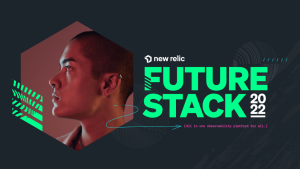Engineers are building and deploying software faster than ever before, thanks to microservices, containers, and cloud technologies. But using fragmented monitoring tools to manage these distributed environments makes problem-solving more siloed, complex, and inefficient. That’s why we built the New Relic platform so engineers can extend it beyond the capabilities available out of the box. And we see our users doing that today because the platform uses common open standards and open source libraries, such as GraphQL and React.
This approach also means that New Relic provides an incredible opportunity for partners to integrate with our platform directly. When you can combine data from all the stages of your development lifecycle and visualize it all in one place, it helps you build better software and build it faster.
As a powerful proof point, we have teamed up with the SaaS network observability company, Kentik, to deliver network performance telemetry data to the New Relic One platform. In December, Kentik and New Relic formed an initial partnership. With today’s partnership expansion, New Relic users can add network context with Kentik-supplied telemetry data that augments their existing application and infrastructure observability data, all within New Relic One.
“The lack of integrated application and network observability continues to claim a high toll in latency and downtime. Even the companies with well-budgeted IT teams are exposed to user experience impact when they do not have a unified view of their environments,” said Avi Freedman, Co-Founder and CEO of Kentik. “Through our expanded partnership with New Relic, we’re helping network and development teams quickly identify and troubleshoot application performance issues correlated with network traffic, performance, and health data, and ultimately make services more reliable.”
The problem
When software fails, it happens in unexpected ways and at the worst time. And when there is a problem in the middle of the night, software engineers often suspect a network failure. But usually, they don’t have the tools or context to diagnose the problem. So they wake up the on-call network engineer, even when they're unsure if there is a network issue at all. As you can imagine, this leads to a lot of frustration, finger-pointing, and slow issue resolution.
DevOps and NetOps teams know there must be a better way. Since modern architectures have eliminated many of the technical boundaries, the time has come to help eliminate the boundaries between teams.
With network context from Kentik in New Relic One, teams will have even better information to help “rule out” or “rule in” the network as the cause of an issue. They can more often let their NetOps team sleep when the network isn’t to blame and provide better context to them when the network is implicated in an issue.
How it works
New Relic and Kentik engineering teams have been working together over the past few weeks, integrating the SNMP and VPC flow data into New Relic One. In fact, this partnership started when Avi set up a free account in New Relic One and started pumping network data into the platform. “We’d been trying all sorts of observability platforms for years,” said Avi, “and we quickly overwhelmed them either with volume or—almost always—with cardinality. So to me, it was amazing that New Relic One not only showed the data super quickly but also let me pull attributes and cardinal values quickly, even over weeks of network data.”
We invite New Relic and Kentik customers to join our early access program to help prove out and refine the solution. Participants can use New Relic One platform capabilities to find and fix network-related software problems.
Let’s look at network telemetry from Kentik in New Relic One to see how engineers could find network-related issues. We can see that we have VPC networks defined automatically by the platform. New Relic Navigator groups them by tag automatically, in this case by VPC region. This is all automatic through tags, with no additional configuration.
Moving over to New Relic Lookout, you can see that New Relic Applied Intelligence has already analyzed the data and shows the volume of network flow in real time, highlighting any anomalies. By clicking on any anomaly, you instantly get more detail about what’s going on in that group.
Finally, with an open source visualization customized to relevant data dimensions, you can see network behavior right alongside application and infrastructure data in a dashboard your team already uses.
And you can achieve this with a simple setup, letting New Relic One do the hard work of identifying and connecting all your network entities to your apps and infrastructure. Your teams then get alerts and AI capabilities, such as anomaly detection in New Relic Lookout, right out of the box. You can view and analyze data in dashboards or custom visualizations.
Our partner integrations today help you in the moments when you’re operating your software—when there’s a problem or when there’s a key change you’re introducing to production. But that’s just the beginning of our vision. In the future, we’re going to integrate more deeply with the tools you use, not only to run your software but the tools you use to plan and build it, too.
다음 단계
If you are a Kentik customer and use New Relic One, join our early access program today! New Relic and Kentik teams are hard at work finalizing the full user experience, and we are planning to deliver all of this later this year. Sign up for early access to start using these capabilities right away.
이 블로그에 표현된 견해는 저자의 견해이며 반드시 New Relic의 견해를 반영하는 것은 아닙니다. 저자가 제공하는 모든 솔루션은 환경에 따라 다르며 New Relic에서 제공하는 상용 솔루션이나 지원의 일부가 아닙니다. 이 블로그 게시물과 관련된 질문 및 지원이 필요한 경우 Explorers Hub(discuss.newrelic.com)에서만 참여하십시오. 이 블로그에는 타사 사이트의 콘텐츠에 대한 링크가 포함될 수 있습니다. 이러한 링크를 제공함으로써 New Relic은 해당 사이트에서 사용할 수 있는 정보, 보기 또는 제품을 채택, 보증, 승인 또는 보증하지 않습니다.



